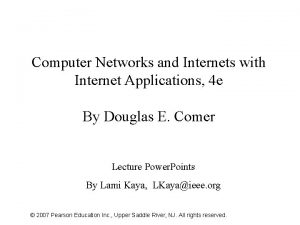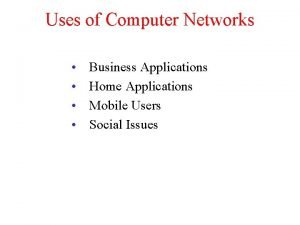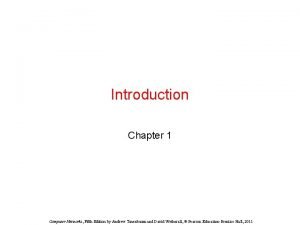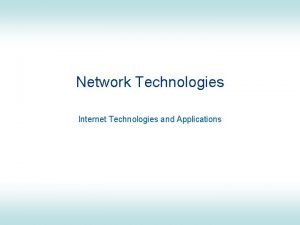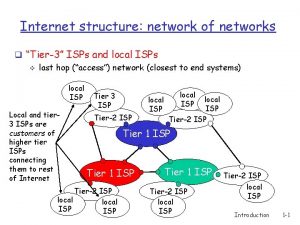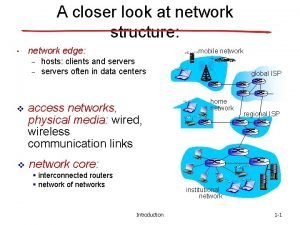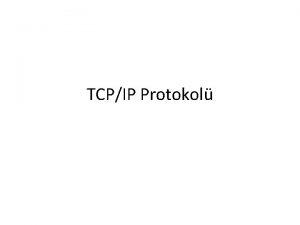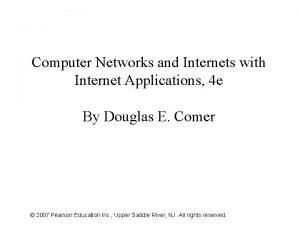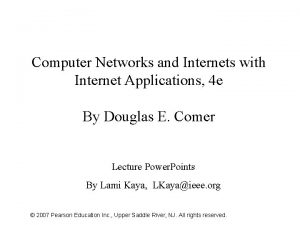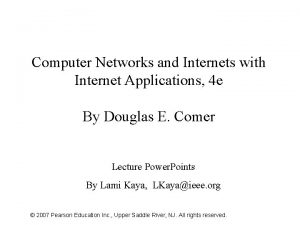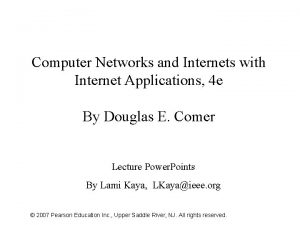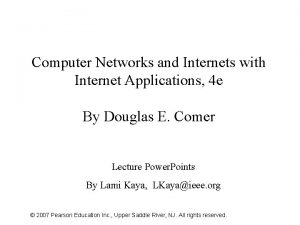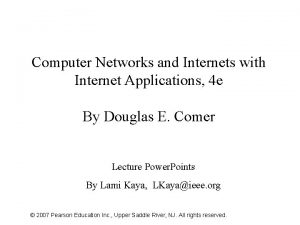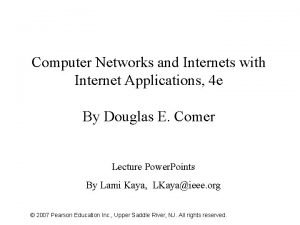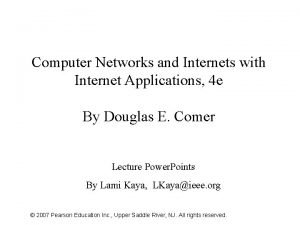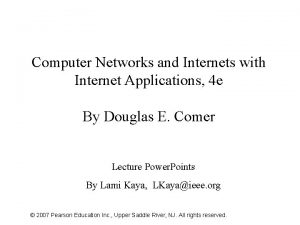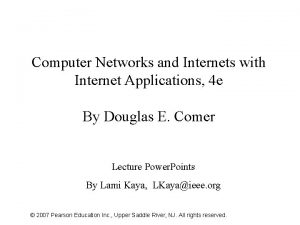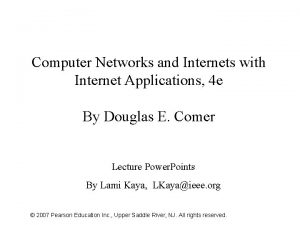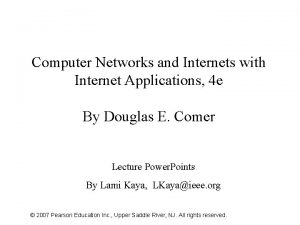Computer Networks and Internets with Internet Applications 4

















- Slides: 17

Computer Networks and Internets with Internet Applications, 4 e By Douglas E. Comer Lecture Power. Points By Lami Kaya, LKaya@ieee. org © 2007 Pearson Education Inc. , Upper Saddle River, NJ. All rights reserved.

Chapter 29 The Socket Interface © 2007 Pearson Education Inc. , Upper Saddle River, NJ. All rights reserved.

Topics Covered • • 29. 1 Introduction 29. 2 Application Program Interface 29. 3 The Socket API 29. 4 Sockets And Socket Libraries 29. 5 Socket Communication And UNIX I/O 29. 6 Sockets, Descriptors, And Network I/O 29. 7 Parameters And The Socket API © 2007 Pearson Education Inc. , Upper Saddle River, NJ. All rights reserved.

Topics Covered (cont. ) • 29. 8 Procedures That Implement The Socket API – – – – 29. 8. 1 The Socket Procedure 29. 8. 2 The Close Procedure 29. 8. 3 The Bind Procedure 29. 8. 4 The Listen Procedure 29. 8. 5 The Accept Procedure 29. 8. 6 The Connect Procedure 29. 8. 7 The Send, Sendto, And Sendmsg Procedures 29. 8. 8 The Recv, Recvfrom, And Recvmsg Procedures • 29. 9 Read And Write With Sockets • 29. 10 Other Socket Procedures • 29. 11 Sockets, Threads, And Inheritance © 2007 Pearson Education Inc. , Upper Saddle River, NJ. All rights reserved.

29. 1 Introduction The chapter • presents the motivation for using client-server • discusses concepts such as concurrency • shows how clients/servers use transport protocols to communicate • provides additional details about client-server interaction by explaining the interface between an application and protocol SW • considers how an application uses protocol SW to communicate • explains an example set of procedures – that an application uses to become a client or a server, – to contact a remote destination, – or to transfer data © 2007 Pearson Education Inc. , Upper Saddle River, NJ. All rights reserved.

29. 2 Application Program Interface • An application must specify some details for communication • An application uses SW tools is known as an – Application Program Interface (API) • An API defines a set of operations that an application can perform when interacting with protocol SW. • Most programming systems define an API – by listing a set of procedures available to applications – the arguments that each procedure expects – and the data types • Usually, an API contains a separate procedure for each logical function © 2007 Pearson Education Inc. , Upper Saddle River, NJ. All rights reserved.

29. 3 The Socket API • Communication protocols do not usually specify an API that applications use to interact with the protocols – Instead, the protocols specify the general operations that should be provided – and allow each OS to define the specific API an application uses to perform the operations • OS designers to choose an API, many have adopted the – “socket API” or simply “socket” • The socket API is available for many OS © 2007 Pearson Education Inc. , Upper Saddle River, NJ. All rights reserved.

29. 4 Sockets And Socket Libraries (1) • From an application programmer's point of view – a “socket library” provides the same semantics as an implementation of sockets in the OS – the program calls socket procedures, which are either supplied by OS procedures or library routines. • In practice, socket libraries are seldom perfect – and minor differences sometimes occur between the standard implementation of a socket API and a socket library © 2007 Pearson Education Inc. , Upper Saddle River, NJ. All rights reserved.

29. 4 Sockets And Socket Libraries (2) • Despite apparent similarities, socket libraries have a completely different implementation than a native socket API supplied by an OS • The code for socket library procedures is linked into the application program and resides in the application's address space • When an application calls a procedure from the socket library – control passes to the library routine which, in turn, makes one or more calls to the underlying OS functions to achieve the desired effect • Functions supplied by the underlying OS need not resemble the socket API at all • Routines in the socket library hide the native OS from the application and present only a socket interface © 2007 Pearson Education Inc. , Upper Saddle River, NJ. All rights reserved.

29. 5 Socket Communication And UNIX I/O • Sockets are integrated with I/O – an application communicates through a socket similar to the way the application transfers data to or from a file – understanding sockets requires one to understand UNIX I/O • UNIX uses an open-read-write-close paradigm for all I/O – the name is derived from the basic I/O operations that apply to both devices and files • For example, – an application must first call “open” to prepare a file for access – The application then calls “read” or “write” to retrieve data from the file or store data in the file – Finally, the application calls “close” to specify that it has finished using the file © 2007 Pearson Education Inc. , Upper Saddle River, NJ. All rights reserved.

29. 6 Sockets, Descriptors, And Network I/O (1) • Before an application can use protocols to communicate – The application must request the OS to create a socket that will be used for communication – The system returns a small integer “descriptor” that identifies the socket – The application then passes the descriptor as an argument when it calls procedures to transfer data across the NW • the application does not need to specify details about the remote destination each time it transfers data • The OS provides a single set of descriptors for files, devices, interprocess communication (IPC) • UNIX provides a pipe mechanism for IPC © 2007 Pearson Education Inc. , Upper Saddle River, NJ. All rights reserved.

29. 6 Sockets, Descriptors, And Network I/O (2) • An application can use the same procedure to send data to – another program, a file, or across a NW • The descriptor represents an object, and the “write” procedure represents a method applied to that object – The underlying object determines how the method is applied • The chief advantage of an integrated system lies in its flexibility – a single application can be written that transfers data to an arbitrary location • If the application is given a descriptor that corresponds to a device – The application sends data to the device • If the application is given a descriptor that corresponds to a file – the application stores data in the file. • If the application is given a descriptor that corresponds to a socket – the application sends data across an internet to a remote machine © 2007 Pearson Education Inc. , Upper Saddle River, NJ. All rights reserved.

29. 7 Parameters And The Socket API • Socket programming differs from conventional I/O – because an application must specify many details to use a socket • For example, – an application must choose a particular transport protocol, – provide the protocol address of a remote machine, – and specify whether the application is a client or a server • To accommodate all the details – each socket has many parameters and options – an application can supply values for each • How should options and parameters be represented in an API? – To avoid having a single socket function with separate parameters for each option, designers of the socket API chose to define many functions. – An application creates a socket and then invokes functions to specify in detail • • The advantage is that most functions have few parameters The disadvantage is that, we must remember to call multiple functions © 2007 Pearson Education Inc. , Upper Saddle River, NJ. All rights reserved.

29. 8 Procedures That Implement The Socket API Please refer to following sub-sections for procedures being used and parameters being passed: – – – – 29. 8. 1 The Socket Procedure 29. 8. 2 The Close Procedure 29. 8. 3 The Bind Procedure 29. 8. 4 The Listen Procedure 29. 8. 5 The Accept Procedure 29. 8. 6 The Connect Procedure 29. 8. 7 The Send, Sendto, And Sendmsg Procedures 29. 8. 8 The Recv, Recvfrom, And Recvmsg Procedures © 2007 Pearson Education Inc. , Upper Saddle River, NJ. All rights reserved.

29. 9 Read And Write With Sockets • Sockets allow applications to use read and write • Like send and recv , read and write do not have arguments that permit the caller to specify a destination • Instead, read and write each have three arguments: – a socket descriptor – the location of a buffer in memory used to store the data – and the length of the memory buffer • The chief advantage of using read and write is generality – an application program can be created that transfers data to or from a descriptor • without knowing whether the descriptor corresponds to a file or a socket • thus, a programmer can use a file on a local disk to test a client or server before attempting to communicate across a NW • The chief disadvantage is that a socket library implementation may introduce additional overhead in the file I/O © 2007 Pearson Education Inc. , Upper Saddle River, NJ. All rights reserved.

29. 10 Other Socket Procedures • The socket API contains other useful procedures • For example, – after a server calls procedure accept to accept an incoming connection request, the server can call procedure “getpeername” • to obtain the complete address of the remote client that initiated the connection – A client or server can also call “gethostname” • to obtain information about the computer on which it is running • Two general-purpose procedures are used to set socket options or obtain a list of current values, an application calls procedure – “setsockopt” to store values in socket options – “getsockopt” to obtain current option values – Options are used mainly to handle special cases © 2007 Pearson Education Inc. , Upper Saddle River, NJ. All rights reserved.

29. 11 Sockets, Threads, And Inheritance • Because many servers are concurrent, the socket API is designed to work with concurrent programs • Although the details depend on the underlying OS implementations of the socket API adhere to the following principle: – Each new thread that is created inherits a copy of all open sockets from the thread that created it © 2007 Pearson Education Inc. , Upper Saddle River, NJ. All rights reserved.
 Computer networks and internets with internet applications
Computer networks and internets with internet applications Computer networks and internets
Computer networks and internets Datagram switching vs virtual circuit
Datagram switching vs virtual circuit Compare internets
Compare internets Basestore iptv
Basestore iptv Uses of computer in business
Uses of computer in business Principles of network applications in computer networks
Principles of network applications in computer networks Business applications of computer networks
Business applications of computer networks Business applications of computer networks
Business applications of computer networks Internet transport protocol in computer networks
Internet transport protocol in computer networks Internet technologies and applications
Internet technologies and applications Tier 3 isp
Tier 3 isp Internet structure network of networks
Internet structure network of networks Which type of address is this: a3:34:45:11:92:f1
Which type of address is this: a3:34:45:11:92:f1 Osi vs tcp/ip
Osi vs tcp/ip Difference between intserv and diffserv
Difference between intserv and diffserv Error detection in computer networks
Error detection in computer networks What is bit and byte stuffing
What is bit and byte stuffing

